This post contains affiliate links. We may get paid an affiliate commission if you buy something or take an action after clicking one of the links on this web page.
Last Updated: July 28, 2019
Shopping on Amazon for knives is a dangerous endeavor. Not only can you find a nearly endless variety of blades, but your account also has a nasty habit of learning your interests. You might not notice it at first. A simple suggestion, “I noticed you like Spyderco. Have you heard of Benchmade?” and suddenly your limited understanding of quality production knives enters a larger world.
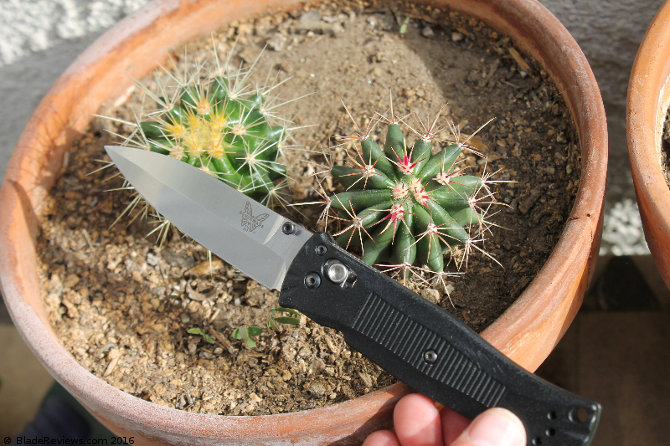
Buy the Benchmade 530 at BladeHQ
It was during the earliest stages of my newfound fanaticism for knives that Amazon did its now dreaded, “get yourself a little something,” and I saw it: The Benchmade 530. It had come up in my searches before. Like an expert hypnotist, the online shopping site had long implanted it in my psyche. I was drawn to the clean lines, the spear-point blade, and the overall symmetry. Benchmade’s Axis lock system and sparkling online reputation caught my attention. Also, I had been really good lately. So I succumbed to the siren’s call: I “got myself a little something.” I purchased the Benchmade 530 and fell one more step down the rabbit hole.
General Dimensions and Blade Details
The Benchmade 530 sports a 3.25” blade and an overall length of 7.42”. The knife is designed by Benchmade’s champion Mel Pardue. Those familiar with Pardue will recognize him as the designer of the Griptilian. Under the hood this knife shares some similar design traits with the Griptilian: reinforced plastic handles, partial liners, and the use of 154CM steel. I tend to view the 530 as a sort of companion piece to the Griptilian; a more elegant and svelte cousin to the rough-and-tumble Grip.
The 530’s blade is a satin-finished or black coated spear point with a long flat edge that terminates in a short and narrow belly. There is also the option to add a semi-serrated blade if it is your preference. The thin blade is ground into a dagger profile with a huge swedge dividing the blade evenly down the middle. This style is very similar to the stiletto style found on some of Mel Pardue’s custom offerings.
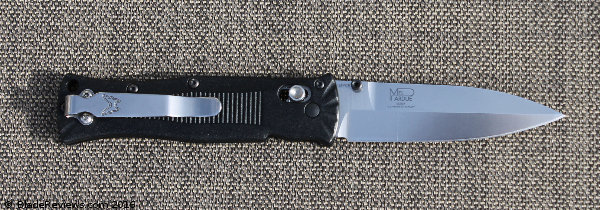
To the unfamiliar this blade may appear to be double-edged, but one side has been left unsharpened as a faux edge. Just as well, because a double edge would be illegal to carry in many states. The shape has led many uninitiated people to refer to the 530 as a switchblade, a comparison that is figuratively double-edged. On one hand the knife is probably intimidating enough to repel a would be mugger. On the other, flicking the blade to open a bag of beef jerky might raise some eyebrows at the mall. Just something to consider.
On paper this blade may look impractical for every-day-carry purposes due to the small belly and dagger grind, but in practice the performance is pleasing. 154CM steel is a staple of Benchmade’s, and for good reason. It is an American mid-range steel that is a good all around performer. The blade’s dagger shape serves several purposes. The deep swedge softens the feel of the back of the knife allowing you to rest your thumb more comfortably on the spine. If you have handled a Spyderco Dragonfly you will have a pretty good idea of how a swedge can bring a little more comfort.
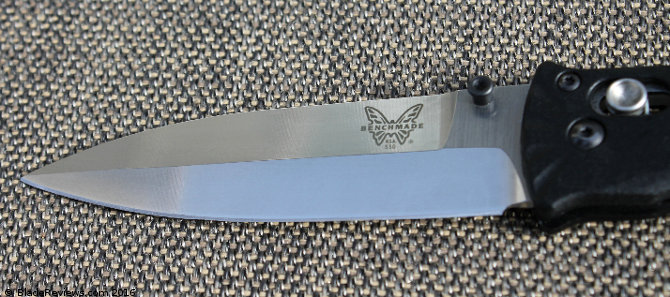
The blade stock is already very thin at 2.29mm, but the grind on this knife makes the blade even more narrow and light while maintaining a strong tip. Because of this, it is a good slicer and excellent piercer. One thing to note about the blade is that it is so thin that it is possible to flex it ever so slightly, but not enough to be troubling for your every day tasks like opening packages or breaking down boxes. That said, I would be cautious to use this knife for hard use activities and it certainly wouldn’t be the only knife I’d bring along on a serious camping trip. While knives with swedges tend to slice a little more poorly than a full flat grind this knife is ground so thin that it seldom has any issue. Still, if a dagger grind isn’t your cup of tea, Benchmade also makes the 531 which sports a full flat ground drop point instead.
All in all, I like the 530’s style. It is what drew me to the knife in the first place and it has proven to be far more practical in practice than one would think.
Handle, Ergonomics, and Pocket Clip
The handle on the 530 is a fiberglass-reinforced nylon called Grivory. Benchmade has received both praise and criticism for similar handle materials in the past. Some people find the plastic cheap and flimsy. I happen to find most FRN handles to be lightweight and deceptively durable, the 530 being no exception. If you aren’t like me and you dislike plastic handles Benchmade again has your solution in the 531, which has handsome gray G10 handles. The 531 weighs a little more than the 530 because of this, but I would think hardly enough to be noticed.
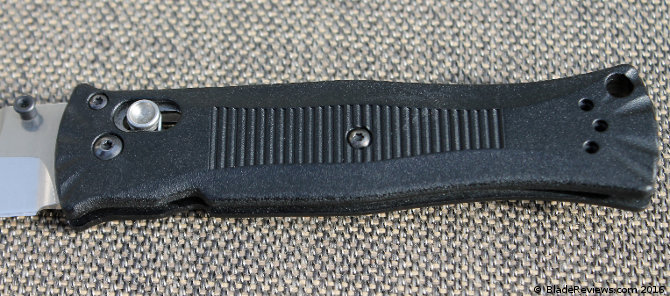
The handle is coffin-shaped; meaning the blade of this knife is relatively straight and nearly symmetrical. Again, like the blade, the handle is deceptively functional. The plastic handles are hollow, but reinforced by bands of plastic segmenting the inner spaces. The back of the handle is mostly of closed construction with only a little bit of flow through where the frame peeks out. It is quite spacious; I can get a four-finger hold on the knife and still have room to spare. I wear a medium sized glove, so I think all but the very largest of hands will be accommodated in full. The plastic handle flares out on every corner, creating a convenient guard that locks the hand in place. These flares create a short finger ramp for exerting more pressure on the blade if required. Because the knife is flared on both ends, it is equally comfortable and functional in a reverse grip.
Some gently notched jimping is cut into the partial frame that is exposed almost exactly like on Pardue’s Griptilian, and like the Griptilian this jimping is appreciated but not particularly effective. There are also grooves set into the handle, light contouring to improve grip, and a very small divot where the thumb stud protrudes when closed that functions as a tiny choil when open. There was some gritty texture on the handle of my example around the chamfered edges. I am not sure if this is to make the knife more grippy or if it was a flaw, but I didn’t like it. Eventually I took some light grit sandpaper to it and it smoothed out easily. This leads me to believe that it probably would have smoothed out with time anyway.
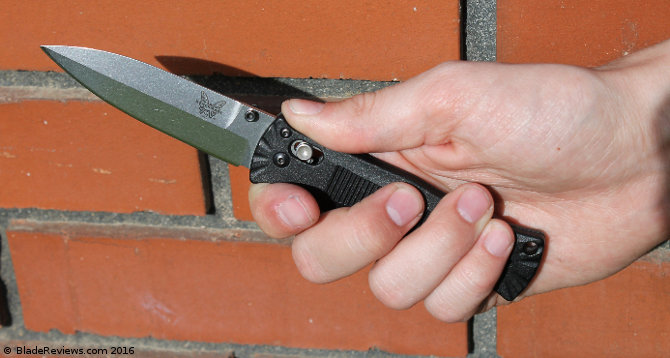
Overall, the handle is functional and comfortable, but do not expect Spyderco or Griptilian-level ergonomics. Honestly, I don’t think anyone would consider this knife if they were just looking for good ergos. Rather, this knife’s charm lies in the thinness and lightness of its construction. This is achieved with a partial steel liner that only extends halfway down the hollowed handle and by the lightness of the blade. This guy is seriously svelte at 1.88 ounces, and with a handle of a mere 0.37th of an inch. You barely even feel it, yet it has a full-length intimidating blade.
By comparison, a Victorinox Alox Cadet is only 0.28 ounces lighter and shares roughly the same width. That being said, one of my favorite uses for this knife is when I go out for a run. I can clip it to my basketball shorts pocket and it doesn’t affect me, nor does it threaten to come loose and fall out. I imagine this knife would also be useful to pack-weight conscious hikers and climbers as well as for those looking for an unobtrusive defensive/practical tool to slip into a purse or pocket.
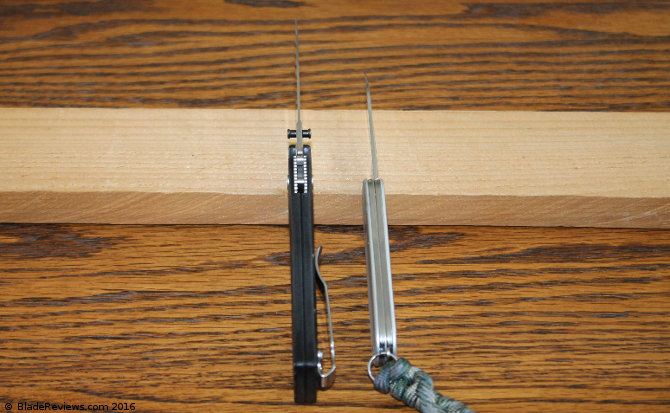
The 530 uses a standard Benchmade split arrow style pocket clip that is painted black. The handle is tapped for tip up, right or left side carry. The clip holds the knife on the pocket, but beyond that I do not like it. It does not bury the knife deeply in the pocket at all. I’d say that roughly ¾ of an inch of the handle sticks out over the edge of the pocket. Deep carry isn’t a huge issue when I pick a knife, but on this one it seems inappropriately shallow. I don’t like that it is simply painted either. It tends to chip and look tacky fairly quickly. The arrow shape is also problematic in my eye. It kept catching the hem threads on my T-shirts and tearing them out as well as slipping into the loops of my pocket stitches and loosening them. On my knife I felt the clip held too tight.
Ultimately, I didn’t want to let a knife I loved be brought down by a clip I didn’t. I contacted Benchmade through email and they immediately sent me a new polished deep-carry pocket clip without charge. I have to commend them on their great customer service. The new clip arrived in a couple of days and I popped it right on. Some slight adjustments later (ie, squishing it between two 2×4’s) and it was 100% perfect. Every issue I had with the old clip was resolved and I have never looked back.
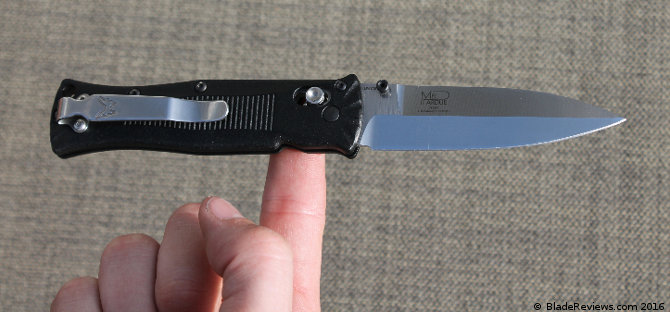
Lastly, I will mention that this knife has a lanyard hole. It is situated on the corner of the butt closest to the closed side of the handle. It appears to be functional (I have never personally seen a need for a lanyard on this knife) and capable of fitting a single run of 550 paracord.
The handle on the 530 is light, relatively tough, and functional. I’d say that it is fairly no nonsense while still complimenting the same overall feel of the blade. That said, I don’t think that this is a knife that would be comfortable for long periods of hard use, but that falls in line with design intent anyway. And it sure looks nice.
Deployment and Lockup
The Benchmade 530 makes use of the company’s proprietary Axis Lock system with dual thumb studs and bronze phosphor washers. The axis lock is quite possibly my favorite design of locking mechanism for a lot of reasons. It is strong, reliable, fast, smooth, completely ambidexterous and incredibly elegant. It keeps one’s fingers free of the blade’s path during closing, which is great for the absent-minded fiddling I tend to do with it. I will note that unlike a lot of Benchmade’s axis locks, the lock bar studs on the 530 are a kind of concave cupped design as opposed to a more convex stacked shape. Unfortunately I have noticed that the cup style is less comfortable, having more of an edge to dig into the fingers. Fortunately, if this is an issue for you, the 531 has you covered, having the standard design. I think that the cupped studs are an attempt to keep the knife profile low and they don’t really bother me, even if I wish they were more standard.
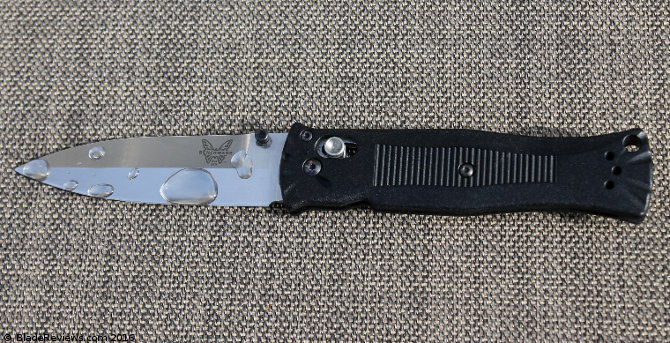
Another thing of note is the so-called “landing gear” style of thumb studs. These reflect the overarching goal of this knife to be slim, as they are only about as wide as the handle at its thickest point. Some people have complained that the thumb studs make this knife hard to flick open. I had issues with this at first as well, but through use I found that if I used the groove leading up to the stud as a guide as I flicked my thumb I could deploy the blade quickly every time. If you can do that, this knife will be a smooth operator for you as well.
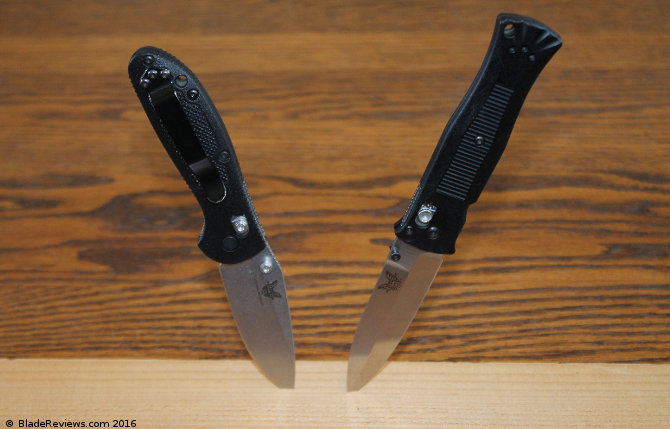
Benchmade 530 – Final Thoughts
The 530 is a knife not without its quirks. It is an ultra light, ultra thin EDC option that could easily be pressed into an emergency defensive role if needed. The knife is sturdy enough for regular use, but not quite as robust as some other offerings. If a harder use blade is your preference I could easily recommend better Benchmade models for the task, but I feel like the 530 fills a nice role in their line and for one of the most moderate prices in their catalogue: just under 100 dollars on Amazon.
I really love the 530 because it fills that same unique role in my collection and it has some killer good looks, but in all honesty the 531 is probably a better knife. It seems like it addresses most issues customers may have perceived in the 530. Still, I am not at all disappointed in my purchase and I would easily recommend the Benchmade 530 for anyone looking for a lean, mean knife.
- HIGH-QUALITY: The 154CM stainless steel blade is tough, rust resistant, and holds an edge well. The G10 handle is durable, impervious to moisture, and stable under extreme temperatures.
- WELL-DESIGNED: Benchmade's AXIS lock is exceptionally strong and fully ambidextrous. The 531 is a manual knife that can be opened and closed with either hand.
- ALWAYS READY: The 531's lightweight design and one-handed opening make it easy to hold and use. The reversible pocket clip offers ultimate accessibility.
- VERSATILE: The 531's drop-point, utility blade style and all-around functionality make it ideal for everyday carry.
- SERVICES AND BENEFITS: For information and terms regarding Benchmade's Limited Warranty and LifeSharp Service, please visit Benchmade's website.
I recommend purchasing the Benchmade 530 at Amazon or BladeHQ. Please consider that purchasing anything through any of the links on this website helps support BladeReviews.com, and keeps the site going. As always, any and all support is greatly appreciated. Thank you very much.
This was a guest review by Jacob Vandenberg. Jacob is a regular reader and all around good guy.

One of my most carried knives due to the weight/length ratio. I’ve thought about getting the 531 because I would prefer a full flat grind, but it is not worth an extra $40 to get a heavier knife.
Larry,
Glad you enjoy this one. I must admit, it’s an intriguing design. I wouldn’t mind picking up the 531 myself.
Dan
Larry,
I really agree. The weight on this one is really fantastic and probably its best feature. I have to say though, after handling the newer G10 handled Griptilians I find myself drawn more and more to the 531.
Jacob
Hey Jacob,
Thank you for a great article!
Actually, the 530 (and, later, the 531) holds his place among my favourite designs from Benchmade. It’s incredibly light, has a quite capable blade, a strong lock and, with pocket clip taken off, fits in a wallet – that’s how I usually carry it.
Though the 530 is lighter and cheaper, to me the 531 looks and feels much more “real”: it cuts better due to high flat grind, G-10 handle feels rock solid, and I even can perform force cuts when needed, which was almost impossible with the 530’s narrow spine of the blade. Also I don’t expect from the 531 to be any worse in piercing, though it’s hardly a common use of this kind of knife.
All in all, if I was given a choice, I would definitely prefer the 531 over 530 despite the price differences.
Best regards,
Vit
Vit,
I’m glad you enjoyed it. Thanks for reading. Knowing what I know now, I tend to agree that the 531 is the more solid and functional of the two. I had never considered wallet carry, but given its unique specs I could see how that would be an option. The 530 series is a great line that really doesn’t seem to get a lot of fanfare. Glad to see that others appreciate it as well.
Best,
Jacob
This knife is nearly identical to the Pardue I picked up a few years back, right down to the 154CM. I personally love it, lightweight in the pocket, foolproof clip, gets and stays super-sharp, up to every task and still looks practically new. Recommended!!
I thought I had left this comment ages ago, but I just wanted to mention that I thought this review was very well written. Hopefully we’ll see you around more!
-Grayson
Thanks for an interesting as well as instructive review of the 530. I’ve gone down a similar rabbit hole lately, it seems, and only met up up with Pardue after acquaintance with the Mini-Barrage and – sweetest of all – the Mini-Emissary. Like Jacob, I was very taken by the lines and elegance of the Pardue, but until I read his review, this was offset by having become completely wired to Benchmade’s assisted opening feature on the other two. So belated thanks, Jason, for having clued me in on using lower bevel of the scale as a ramp to guide a thumbnail flick. After just a few tries I’m on much better terms with my new Pardue, and am much obliged for your advice about this. In return, I’d like to encourage anyone who admires the slenderness and gracefulness of the Pardue to check out the small Emissary. It has similar virtues, I think you’ll find, superadded to which is which is a really quite wonderful se of deployment characteristics… especially if you use the scale groove nearest the stud(s) as a guide in much the same way Jason encourages us to use the Pardue’s bevel. I had come to that one myself, because the milling of this groove invites this expedient sooner or later simply through repeated use. In any case thanks againfor a thoughtful and inviting take on the Pardu, and here’s whipping you might five the small Emissary a boo if you haven’t already done so.
Cheers.